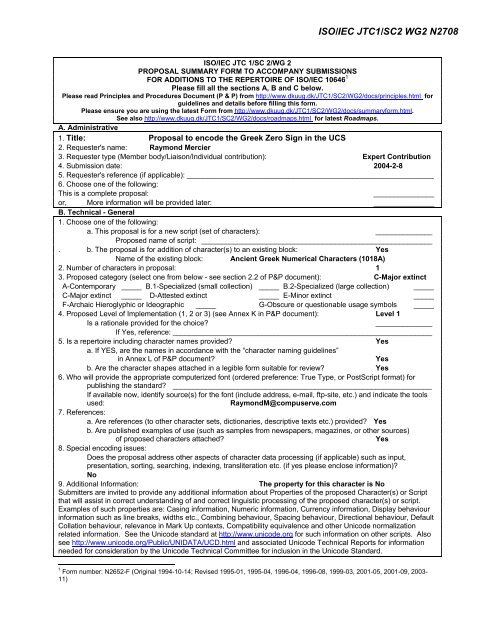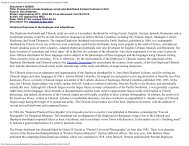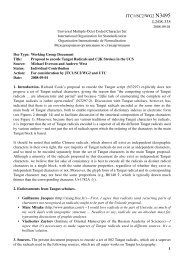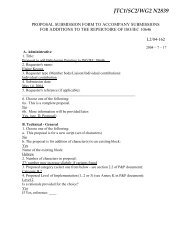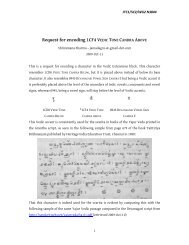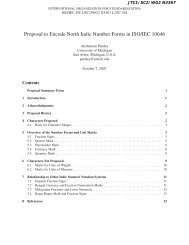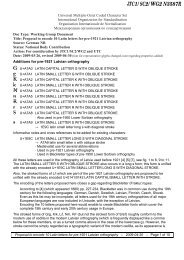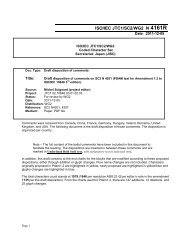ISO/IEC JTC1/SC2 WG2 N2708 - DKUUG standardizing
ISO/IEC JTC1/SC2 WG2 N2708 - DKUUG standardizing
ISO/IEC JTC1/SC2 WG2 N2708 - DKUUG standardizing
You also want an ePaper? Increase the reach of your titles
YUMPU automatically turns print PDFs into web optimized ePapers that Google loves.
<strong>ISO</strong>/<strong>IEC</strong> JTC 1/SC 2/WG 2<br />
PROPOSAL SUMMARY FORM TO ACCOMPANY SUBMISSIONS<br />
FOR ADDITIONS TO THE REPERTOIRE OF <strong>ISO</strong>/<strong>IEC</strong> 10646 1<br />
Please fill all the sections A, B and C below.<br />
Please read Principles and Procedures Document (P & P) from http://www.dkuug.dk/<strong>JTC1</strong>/<strong>SC2</strong>/<strong>WG2</strong>/docs/principles.html for<br />
guidelines and details before filling this form.<br />
Please ensure you are using the latest Form from http://www.dkuug.dk/<strong>JTC1</strong>/<strong>SC2</strong>/<strong>WG2</strong>/docs/summaryform.html.<br />
See also http://www.dkuug.dk/<strong>JTC1</strong>/<strong>SC2</strong>/<strong>WG2</strong>/docs/roadmaps.html for latest Roadmaps.<br />
A. Administrative<br />
1. Title: Proposal to encode the Greek Zero Sign in the UCS<br />
2. Requester's name: Raymond Mercier<br />
3. Requester type (Member body/Liaison/Individual contribution): Expert Contribution<br />
4. Submission date: 2004-2-8<br />
5. Requester's reference (if applicable): _____________________________________________________________<br />
6. Choose one of the following:<br />
This is a complete proposal: _______________<br />
or, More information will be provided later: _______________<br />
B. Technical - General<br />
1. Choose one of the following:<br />
a. This proposal is for a new script (set of characters): ______________<br />
Proposed name of script: _________________________________________________________<br />
. b. The proposal is for addition of character(s) to an existing block: Yes<br />
Name of the existing block: Ancient Greek Numerical Characters (1018A)<br />
2. Number of characters in proposal: 1<br />
3. Proposed category (select one from below - see section 2.2 of P&P document): C-Major extinct<br />
A-Contemporary _____ B.1-Specialized (small collection) _____ B.2-Specialized (large collection) _____<br />
C-Major extinct _____ D-Attested extinct _____ E-Minor extinct _____<br />
F-Archaic Hieroglyphic or Ideographic _____ G-Obscure or questionable usage symbols _____<br />
4. Proposed Level of Implementation (1, 2 or 3) (see Annex K in P&P document): Level 1<br />
Is a rationale provided for the choice? ______________<br />
If Yes, reference: ________________________________________________________________<br />
5. Is a repertoire including character names provided? Yes<br />
a. If YES, are the names in accordance with the “character naming guidelines”<br />
in Annex L of P&P document? Yes<br />
b. Are the character shapes attached in a legible form suitable for review? Yes<br />
6. Who will provide the appropriate computerized font (ordered preference: True Type, or PostScript format) for<br />
publishing the standard? ________________________________________________________________<br />
If available now, identify source(s) for the font (include address, e-mail, ftp-site, etc.) and indicate the tools<br />
used: RaymondM@compuserve.com<br />
7. References:<br />
a. Are references (to other character sets, dictionaries, descriptive texts etc.) provided? Yes<br />
b. Are published examples of use (such as samples from newspapers, magazines, or other sources)<br />
of proposed characters attached? Yes<br />
8. Special encoding issues:<br />
Does the proposal address other aspects of character data processing (if applicable) such as input,<br />
presentation, sorting, searching, indexing, transliteration etc. (if yes please enclose information)?<br />
No<br />
9. Additional Information: The property for this character is No<br />
Submitters are invited to provide any additional information about Properties of the proposed Character(s) or Script<br />
that will assist in correct understanding of and correct linguistic processing of the proposed character(s) or script.<br />
Examples of such properties are: Casing information, Numeric information, Currency information, Display behaviour<br />
information such as line breaks, widths etc., Combining behaviour, Spacing behaviour, Directional behaviour, Default<br />
Collation behaviour, relevance in Mark Up contexts, Compatibility equivalence and other Unicode normalization<br />
related information. See the Unicode standard at http://www.unicode.org for such information on other scripts. Also<br />
see http://www.unicode.org/Public/UNIDATA/UCD.html and associated Unicode Technical Reports for information<br />
needed for consideration by the Unicode Technical Committee for inclusion in the Unicode Standard.<br />
1 Form number: N2652-F (Original 1994-10-14; Revised 1995-01, 1995-04, 1996-04, 1996-08, 1999-03, 2001-05, 2001-09, 2003-<br />
11)<br />
<strong>ISO</strong>/<strong>IEC</strong> <strong>JTC1</strong>/<strong>SC2</strong> <strong>WG2</strong> <strong>N2708</strong>
C. Technical - Justification<br />
1. Has this proposal for addition of character(s) been submitted before? No<br />
If YES explain _________________________________________________________________________<br />
2. Has contact been made to members of the user community (for example: National Body,<br />
user groups of the script or characters, other experts, etc.)? ______________<br />
If YES, with whom? Members of the scholarly community<br />
If YES, available relevant documents: ________________________________________________<br />
3. Information on the user community for the proposed characters (for example:<br />
size, demographics, information technology use, or publishing use) is included? Scholars<br />
Reference: ___________________________________________________________________________<br />
4. The context of use for the proposed characters (type of use; common or rare) Common in Greek papyri,<br />
manuscripts and printed editions<br />
Reference:<br />
5. Are the proposed characters in current use by the user community? Yes<br />
If YES, where? Reference: See proposal<br />
Character present in various editions of Greek texts, used by scholars of Greek<br />
6. After giving due considerations to the principles in the P&P document must the proposed characters be entirely<br />
in the BMP? Yes<br />
If YES, is a rationale provided? Accordance with the Roadmap<br />
If YES, reference: ________________________________________________________<br />
7. Should the proposed characters be kept together in a contiguous range (rather than being scattered)? N/A<br />
8. Can any of the proposed characters be considered a presentation form of an existing<br />
character or character sequence? No<br />
If YES, is a rationale for its inclusion provided? ______________<br />
If YES, reference: ________________________________________________________<br />
9. Can any of the proposed characters be encoded using a composed character sequence of either<br />
existing characters or other proposed characters? No<br />
If YES, is a rationale for its inclusion provided? ______________<br />
If YES, reference: ______________<br />
10. Can any of the proposed character(s) be considered to be similar (in appearance or function)<br />
to an existing character? No<br />
If YES, is a rationale for its inclusion provided? ______________<br />
If YES, reference: ________________________________________________________<br />
11. Does the proposal include use of combining characters and/or use of composite sequences? No<br />
If YES, is a rationale for such use provided? ______________<br />
If YES, reference: _______________________________________________________<br />
Is a list of composite sequences and their corresponding glyph images (graphic symbols)<br />
provided? ______________<br />
If YES, reference: _______________________________________________________<br />
12. Does the proposal contain characters with any special properties such as<br />
control function or similar semantics? No<br />
If YES, describe in detail (include attachment if necessary) ______________<br />
13. Does the proposal contain any Ideographic compatibility character(s)? No<br />
If YES, is the equivalent corresponding unified ideographic character(s) identified? ____________<br />
If YES, reference: ________________________________________________________
Consideration of the Greek symbol ‘zero’<br />
Raymond Mercier<br />
RaymondM@compuserve.com<br />
The Unicode Character Set has no codepoint for ‘zero’ among the Greek symbols. This symbol<br />
occurs notably whenever a sexagesimal notation is used in astronomical texts to record degrees,<br />
minutes and seconds, or hours minutes and seconds. In this proposal I present evidence from papyri,<br />
manuscripts and printed texts to show the various forms of this symbol, and I urge the acceptance<br />
of an agreed codepoint for it. This is important if editions of Greek astronomical texts are to be<br />
recorded satisfactorily in Unicode.<br />
As will be clear from these notes zero appears in a variety of forms, with a marked change towards<br />
the end of the medieval period. Nevertheless it might be best to regard these are scribal variations,<br />
without any need to create a separate codepoint for the later forms.<br />
CUNEIFORM TEXTS<br />
In later Babylonian astronomical texts, of the Seleucid period, the zero in sexagesimal notation is<br />
marked by a separation symbol. This is listed in Labat’s Manuel d’Épigraphie Akkadienne,<br />
This is found in astronomical texts, such as this, reproduced from Kugler’s Babylonische<br />
Mondrechnung, Tafel II, and its transcription, p. 34.<br />
The zero, marked by a separation sign, is clear in the third row.<br />
As Jones remarks in the passage quoted below, the cuneiform sign is more plausibly the source of<br />
the zero in the papyri, rather than from an abbreviation of oÑdέn
PAPYRI<br />
Erik J.Knudtzon, O.Neugebauer, ‘Zwei astronomische Texte’, Bulletin de la Société Royale de<br />
Lettres de Lund (Kungl. Humanistiska Vetenskapssamfundet i Lund) 1946-7, 77-88, 2 Plates.<br />
This is a study of an astronomical table in P. Lund 35a . The zero appears clearly in Tafel 1, in line<br />
7 of col.vii : .<br />
which is transcribed (p. 79) as<br />
Georges Ifrah, Histoire universelle de chiffres, Paris : Robert Lafont, 1994.<br />
In Vol. I, p. 375, we have an illustration of other forms of zero found in papyri.
The form shown for Pap. London 1278 is more representative of that found in other astronomical<br />
papyri. That shown in Pap. Aberdeen 128 is clearly a cursive form, from which the ductus is clear,<br />
a line starting at the upper right, and ending with a half-drawn circle under the stroke.<br />
A. Jones, Astronomical Papyri from Oxyrhynchus (P. Oxy. 4133–4300a), American Philosophical<br />
Society, 1999.<br />
p. 61:<br />
The symbol for zero is a special case in that it probably does not stand<br />
in place of a specific word. It represents either an ‘empty’ place in a<br />
sexagesimal fraction or 'no whole units' (usually preceding a sexagesimal<br />
fraction). It was always closely tied to the sexagesimal notation, and<br />
only occurs in astronomical contexts. The most common form of zero in the<br />
papyri is a small circle with a horizontal stroke above it, but there are<br />
many variations (Fig. 16, below). The stroke is not the horizontal bar<br />
sometimes written above alphabetic numerals; the latter is never drawn<br />
above a zero, and is generally written further above the base line. I<br />
share Neugebauer's doubts of the supposition often repeated in<br />
paleographical handbooks that the symbol was an abbreviation of οὐδέν<br />
(Neugebauer [1957b] 14). It was the counter- part of the cuneiform<br />
punctuation mark , which was used in the same way in sexagesimal<br />
numerals, and the direct ancestor of the zero of Arabic astronomical<br />
manuscripts (Irani [1955]). A Demotic counterpart is known only from P.<br />
Carlsberg 32, where the occurrences are unfortunately damaged so that it<br />
is not clear whether the horizontal stroke that can be seen was the<br />
entire symbol or only part of it.
There are a great many tables in which the zero is shown. Of these there are eleven photographs in<br />
the Plates. This is a list of the papyri that are illustrated in the plates, together with the form of zero<br />
symbol used in each.<br />
Plate line etc zero<br />
4136 II ϙ<br />
4138 XI 10 ϙ<br />
4152 III 3,4 ϙ<br />
4154 III 6 ϙ<br />
4155 III bottom ϙ<br />
4163 IV bottom ϙ<br />
4165 VI col.iii, etc ϙ<br />
4167 fr.3 V col.v ϙ<br />
4174a VI col.i line 1 o<br />
___<br />
4203a X ϙ<br />
4205 V col.i, bottom ϙ<br />
The photo of 4167 in Plate V is reasonably clear, with many examples of zero.
The zero shown here is quite typical of all the papyri shown in the Plates, with the<br />
curious exception of P4174a, where it appears as ___, o with the line drawn under the<br />
small o.
MANUSCRIPTS<br />
Fifth century<br />
O. Neugebauer and H.B. van Hoesen, Greek Horoscopes, American Philosophical<br />
Society, 1959; pp. 152-157, 188.<br />
The examples in this volume are taken from a variety of sources, epigraphs, papyri,<br />
and manuscripts. Among the manuscripts there is a clear example in the horoscope<br />
L.497. This is dateable to A.D. 497, and is found in three manuscripts Vienna, Cod.<br />
phil. gr. 179; Modena, Cod. 85; Florence, Laur 28/34. The zero is found in the line<br />
Transcription:<br />
♂ ♌ ιζ ̅ λε ́ · ♃ δ ̅ ιβ ́<br />
τύχη ις̅ ο̅<br />
Mars Leo 17;35, Jupiter 4;12<br />
Lot 16;0<br />
Here the bar over the zero is rather shorter than in the papyri, so the result is much the<br />
same as omicron + macron.
Ninth century<br />
In ninth century Byzantine manuscripts the character for zero differs little from the<br />
papyri. For example in Vat gr 1291 fol.31,<br />
ΣΟΑ ΛΖ ΙΒ Α<br />
ΣΟΒ ΜΗ ΙΒ Ō<br />
Here the zero consists of a full size uncial omicron with a macron.<br />
Florence Laur 28/26 (ca 886-912) fol. 121.<br />
Uncial script.<br />
The last two lines read:<br />
ϙ Η ϙ ΙΒ<br />
Β ϙ Α ΚΣ<br />
Here the zero shows a closer resemblance to that in the papyri than to the zero in the<br />
contemporary manuscript Vat gr 1291 shown above.
Fourteenth century<br />
In the some late medieval manuscripts the form of the symbol has altered<br />
considerably. For example, from a fourteenth century Byzantine manuscript (Escorial<br />
Σ-I-11, fol.53r), a copy of the Persian Syntaxis. For zero we have a character that<br />
might have arisen from a very cursive handling of the older ō, or ϙ, but is<br />
nevertheless quite different from it.<br />
which reads<br />
12;58 13;55<br />
13;0 13;57<br />
Here the zero is quite similar to the Coptic (U+03E5); of course it is not suggested<br />
that there is any historical connection with the Coptic character.
Fifteenth century<br />
Manuscript of the Astronomical Manual of Gemistos Plethon<br />
Vienna phil gr 140, fol.90<br />
The zero appears repeatedly in the central column. This is a small circle surmounted<br />
by a line, of such a size that the whole no larger than other Greek characters, that is<br />
smaller than omicron + macron.
Twelfth century Arabic<br />
Manuscript of the Zīj al-Sanjarī<br />
Private possession, sold by Quaritch (London), fol.141r.<br />
ﻪﻟ ō ا<br />
ō ا ب<br />
ﻻ ا ج<br />
ب ب د<br />
The zero symbol clearly follows the Greek papyri.
Twelfth century Arabic<br />
Manuscript of the Zīj al-Sanjarī<br />
Vatican Library, Vat. ar. 761 fol.168.<br />
The first row shows an exceptionally clear example of the zero.
Thirteenth century Persian<br />
Manuscript of the Zīj-i Īlkhānī<br />
Cambridge University Library, Browne O.2.7, fol.9r<br />
ϥ ϥ ϥ ﺪﻜﻗ<br />
ϥ<br />
ح ب [ϥ] ﺞﻜﻗ ا<br />
ب د[ϥ]<br />
ﺐﻜﻗ ب<br />
The zero symbol is clearly a cursive development from the regular circle with the<br />
macron. This form is found almost unchanged in the Persian Syntaxis noted above,<br />
which is in fact a Greek version of the Zīj-i Īlkhānī.
PRINTED EDITIONS<br />
J.L.Heiberg, Claudii Ptolemaei, Opera Astronomica Minora, Leipzig: Teubner, 1907.<br />
In the Greek texts edited here Heiberg has used symbols for the Greek zero that vary<br />
from one text to another.<br />
p.78<br />
In this edition of the Planetary Hypotheses, Heiberg, in the last line, has used a simple<br />
circle is used to represent zero. It is the same size as the Greek characters.<br />
p.150<br />
Through the edition of this text, Inscriptio Canobi, Heiberg has used an omicron<br />
together with an accent sometimes called Vrachy.<br />
p.169<br />
In this edition of the Handy Tables Heiberg has used an ordinary Latin number zero.
Ivor Thomas, Greek Mathematics, volume II, Loeb Classical Library, London &<br />
Cambridge Mass.,1951.<br />
In this volume zero is found in extracts from Ptolemy’s Syntaxis, where it is printed as<br />
a circle, slightly distinct from omicron.<br />
Compare this zero with lower case omicron in the table on page 444.<br />
p. 444<br />
The number is 0;31,25. written in the way that is now commonplace for sexagesimal<br />
numbers.<br />
Elsewhere a larger circle is used for zero, which may be compared with the upper case<br />
omicron (p.422)<br />
p.440<br />
p.422<br />
These show that although the editor has not been entirely consistent in the form of<br />
zero, he has always used a character differing from the lower and upper case omicron.<br />
On the other hand the Latin letter O in Arial font, is very close to this ‘zero’. The<br />
number is 0;47,8.
Georges Ifrah, Histoire universelle de chiffres, Paris : Robert Lafont, 1994.<br />
A. Jones, Astronomical Papyri from Oxyrhynchus (P. Oxy. 4133–4300a), American<br />
Philosophical Society, 1999.<br />
Erik J.Knudtzon, O.Neugebauer, ‘Zwei astronomische Texte’, Bulletin de la Société<br />
Royale de Lettres de Lund (Kungl. Humanistiska Vetenskapssamfundet i Lund) 1946-7,<br />
77-88, 2 Plates.<br />
F. X. Kugler, Babylonische Mondrechnung, Freiburg im Breisgau, 1900.<br />
R. Labat, Manuel d’Épigraphie Akkadienne, Paris, 1948.<br />
Ivor Thomas, Greek Mathematics, volume II, Loeb Classical Library, London &<br />
Cambridge Mass.,1951.


